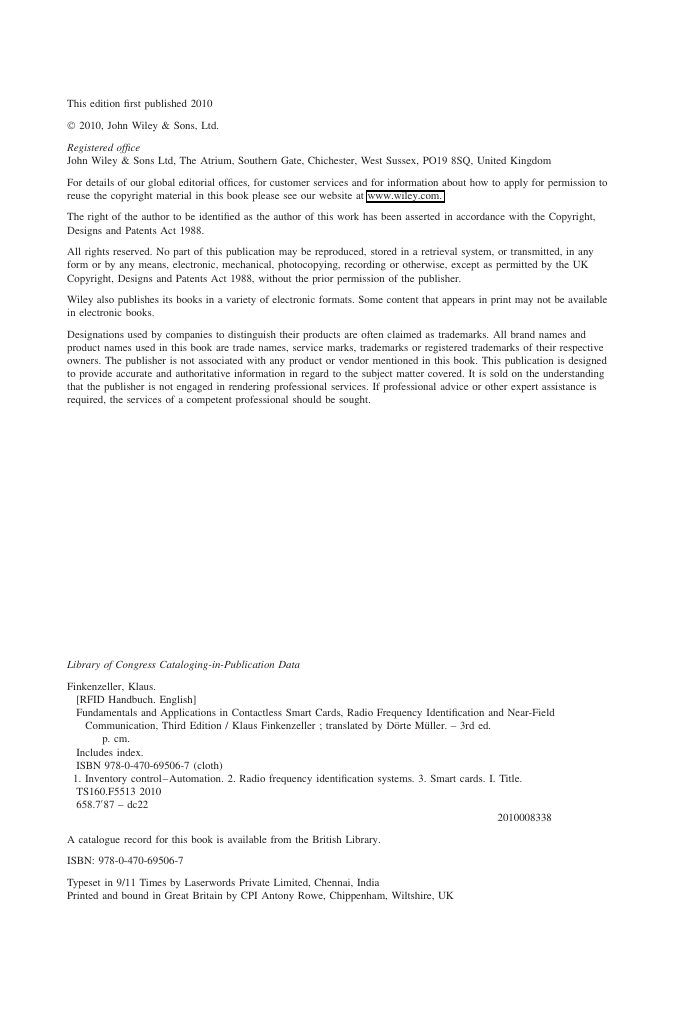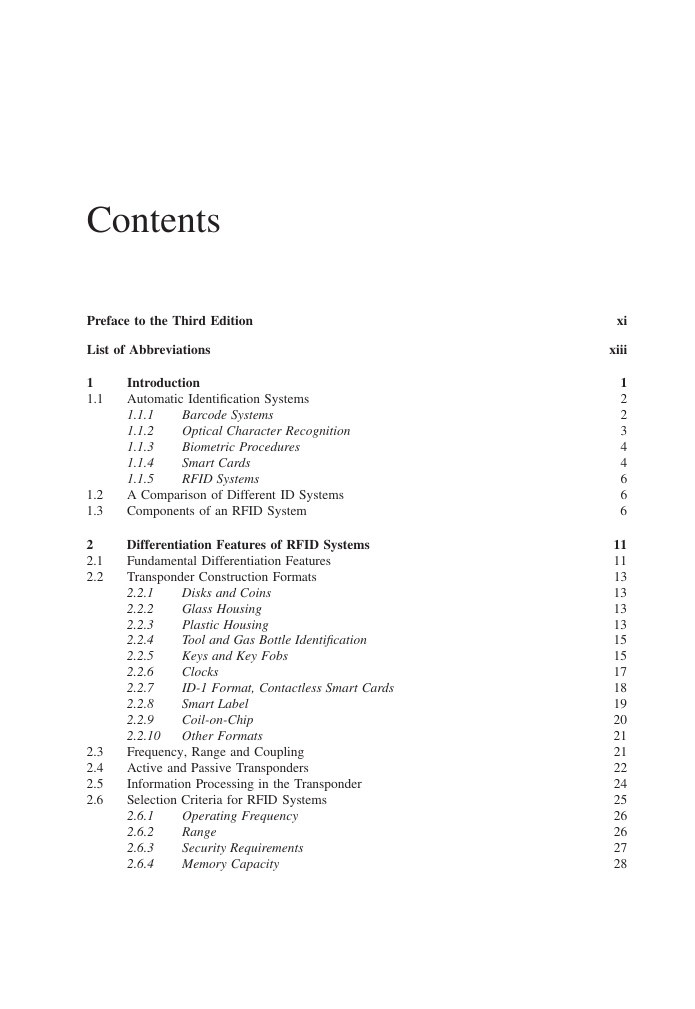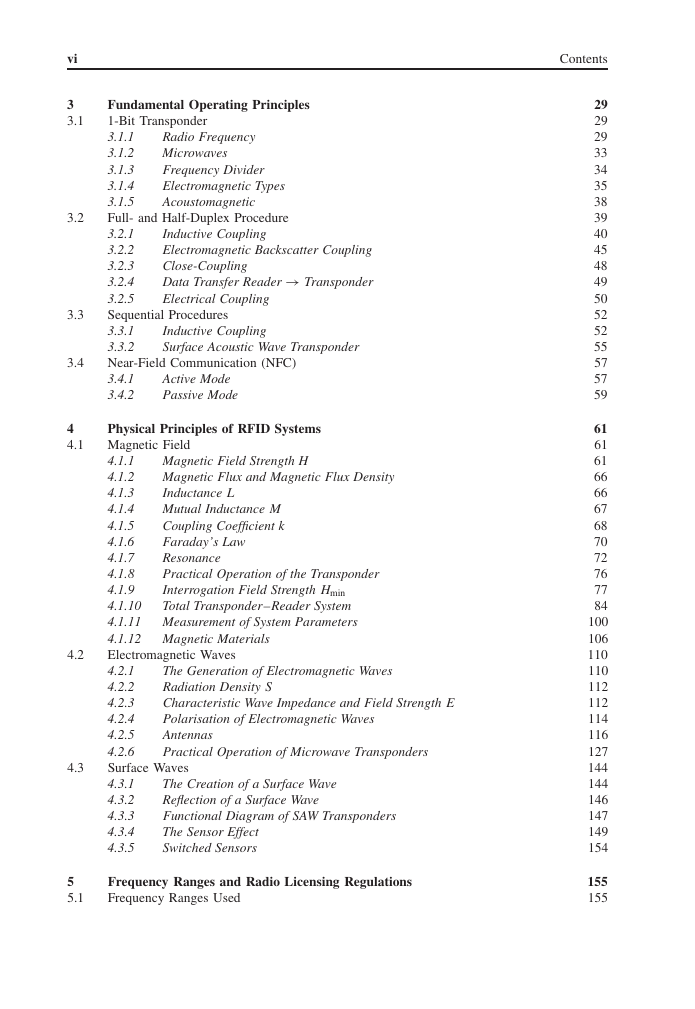RFID HANDBOOK
Contents
Preface to the Third Edition
List of Abbreviations
1 Introduction
1.1 Automatic Identification Systems
1.1.1 Barcode Systems
1.1.2 Optical Character Recognition
1.1.3 Biometric Procedures
1.1.4 Smart Cards
1.1.5 RFID Systems
1.2 A Comparison of Different ID Systems
1.3 Components of an RFID System
2 Differentiation Features of RFID Systems
2.1 Fundamental Differentiation Features
2.2 Transponder Construction Formats
2.2.1 Disks and Coins
2.2.2 Glass Housing
2.2.3 Plastic Housing
2.2.4 Tool and Gas Bottle Identification
2.2.5 Keys and Key Fobs
2.2.6 Clocks
2.2.7 ID-1 Format, Contactless Smart Cards
2.2.8 Smart Label
2.2.9 Coil-on-Chip
2.2.10 Other Formats
2.3 Frequency, Range and Coupling
2.4 Active and Passive Transponders
2.5 Information Processing in the Transponder
2.6 Selection Criteria for RFID Systems
2.6.1 Operating Frequency
2.6.2 Range
2.6.3 Security Requirements
2.6.4 Memory Capacity
3 Fundamental Operating Principles
3.1 1-Bit Transponder
3.1.1 Radio Frequency
3.1.2 Microwaves
3.1.3 Frequency Divider
3.1.4 Electromagnetic Types
3.1.5 Acoustomagnetic
3.2 Full- and Half-Duplex Procedure
3.2.1 Inductive Coupling
3.2.2 Electromagnetic Backscatter Coupling
3.2.3 Close-Coupling
3.2.4 Data Transfer Reader → Transponder
3.2.5 Electrical Coupling
3.3 Sequential Procedures
3.3.1 Inductive Coupling
3.3.2 Surface Acoustic Wave Transponder
3.4 Near-Field Communication (NFC)
3.4.1 Active Mode
3.4.2 Passive Mode
4 Physical Principles of RFID Systems
4.1 Magnetic Field
4.1.1 Magnetic Field Strength H
4.1.2 Magnetic Flux and Magnetic Flux Density
4.1.3 Inductance L
4.1.4 Mutual Inductance M
4.1.5 Coupling Coefficient k
4.1.6 Faraday’s Law
4.1.7 Resonance
4.1.8 Practical Operation of the Transponder
4.1.9 Interrogation Field Strength Hmin
4.1.10 Total Transponder–Reader System
4.1.11 Measurement of System Parameters
4.1.12 Magnetic Materials
4.2 Electromagnetic Waves
4.2.1 The Generation of Electromagnetic Waves
4.2.2 Radiation Density S
4.2.3 Characteristic Wave Impedance and Field Strength E
4.2.4 Polarisation of Electromagnetic Waves
4.2.5 Antennas
4.2.6 Practical Operation of Microwave Transponders
4.3 Surface Waves
4.3.1 The Creation of a Surface Wave
4.3.2 Reflection of a Surface Wave
4.3.3 Functional Diagram of SAW Transponders
4.3.4 The Sensor Effect
4.3.5 Switched Sensors
5 Frequency Ranges and Radio Licensing Regulations
5.1 Frequency Ranges Used
5.1.1 Frequency Range 9–135 kHz
5.1.2 Frequency Range 6.78MHz (ISM)
5.1.3 Frequency Range 13.56MHz (ISM, SRD)
5.1.4 Frequency Range 27.125MHz (ISM)
5.1.5 Frequency Range 40.680MHz (ISM)
5.1.6 Frequency Range 433.920MHz (ISM)
5.1.7 UHF Frequency Range
5.1.8 Frequency Range 2.45GHz (ISM, SRD)
5.1.9 Frequency Range 5.8GHz (ISM, SRD)
5.1.10 Frequency Range 24.125GHz
5.1.11 Selection of a Suitable Frequency for Inductively Coupled RFID Systems
5.2 The International Telecommunication Union (ITU)
5.3 European Licensing Regulations
5.3.1 CEPT/ERC REC 70-03
5.3.2 Standardised Measuring Procedures
5.4 National Licensing Regulations in Europe
5.4.1 Germany
5.5 National Licensing Regulations
5.5.1 USA
5.6 Comparison of National Regulations
5.6.1 Conversion at 13.56MHz
5.6.2 Conversion on UHF
6 Coding and Modulation
6.1 Coding in the Baseband
6.2 Digital Modulation Procedures
6.2.1 Amplitude Shift Keying (ASK)
6.2.2 2 FSK
6.2.3 2 PSK
6.2.4 Modulation Procedures with Subcarrier
7 Data Integrity
7.1 The Checksum Procedure
7.1.1 Parity Checking
7.1.2 LRC Procedure
7.1.3 CRC Procedure
7.2 Multi-Access Procedures – Anticollision
7.2.1 Space Division Multiple Access (SDMA)
7.2.2 Frequency Domain Multiple Access (FDMA)
7.2.3 Time Domain Multiple Access (TDMA)
7.2.4 Examples of Anticollision Procedures
8 Security of RFID Systems
8.1 Attacks on RFID Systems
8.1.1 Attacks on the Transponder
8.1.2 Attacks on the RF Interface
8.2 Protection by Cryptographic Measures
8.2.1 Mutual Symmetrical Authentication
8.2.2 Authentication using Derived Keys
8.2.3 Encrypted Data Transfer
9 Standardisation
9.1 Animal Identification
9.1.1 ISO/IEC 11784 – Code Structure
9.1.2 ISO/IEC 11785 – Technical Concept
9.1.3 ISO/IEC 14223 – Advanced Transponders
9.2 Contactless Smart Cards
9.2.1 ISO/IEC 10536 – Close-Coupling Smart Cards
9.2.2 ISO/IEC 14443 – Proximity-Coupling Smart Cards
9.2.3 ISO/IEC 15693 – Vicinity-Coupling Smart Cards
9.2.4 ISO/IEC 10373 – Test Methods for Smart Cards
9.3 ISO/IEC 69873 – Data Carriers for Tools and Clamping Devices
9.4 ISO/IEC 10374 – Container Identification
9.5 VDI 4470 – Anti-theft Systems for Goods
9.5.1 Part 1 – Detection Gates – Inspection Guidelines for Customers
9.5.2 Part 2 – Deactivation Devices – Inspection Guidelines for Customers
9.6 Item Management
9.6.1 ISO/IEC 18000 Series
9.6.2 GTAG Initiative
9.6.3 EPCglobal Network
10 The Architecture of Electronic Data Carriers
10.1 Transponder with Memory Function
10.1.1 RF Interface
10.1.2 Address and Security Logic
10.1.3 Memory Architecture
10.2 Microprocessors
10.2.1 Dual Interface Card
10.3 Memory Technology
10.3.1 RAM
10.3.2 EEPROM
10.3.3 FRAM
10.3.4 Performance Comparison FRAM – EEPROM
10.4 Measuring Physical Variables
10.4.1 Transponder with Sensor Functions
10.4.2 Measurements Using Microwave Transponders
10.4.3 Sensor Effect in Surface Wave Transponders
11 Readers
11.1 Data Flow in an Application
11.2 Components of a Reader
11.2.1 RF Interface
11.2.2 Control Unit
11.3 Integrated Reader ICs
11.3.1 Integrated RF Interface
11.3.2 Single-Chip Reader IC
11.4 Connection of Antennas for Inductive Systems
11.4.1 Connection Using Current Matching
11.4.2 Supply via Coaxial Cable
11.4.3 The Influence of the Q Factor
11.5 Reader Designs
11.5.1 OEM Readers
11.5.2 Readers for Industrial Use
11.5.3 Portable Readers
11.6 Near-Field Communication
11.6.1 Secure NFC
12 The Manufacture of Transponders and Contactless Smart Cards
12.1 Glass and Plastic Transponders
12.1.1 Chip Manufacture
12.1.2 Glass Transponders
12.1.3 Plastic Transponders
12.2 Contactless Smart Cards
12.2.1 Coil Manufacture
12.2.2 Connection Technique
12.2.3 Lamination
13 Example Applications
13.1 Contactless Smart Cards
13.2 Public Transport
13.2.1 The Starting Point
13.2.2 Requirements
13.2.3 Benefits of RFID Systems
13.2.4 Fare Systems using Electronic Payment
13.2.5 Market Potential
13.2.6 Example Projects
13.3 Contactless Payment Systems
13.3.1 MasterCard
13.3.2 ExpressPay by American Express
13.3.3 Visa Contactless
13.3.4 ExxonMobil Speedpass
13.4 NFC Applications
13.5 Electronic Passport
13.6 Ski Tickets
13.7 Access Control
13.7.1 Online Systems
13.7.2 Offline Systems
13.7.3 Transponders
13.8 Transport Systems
13.8.1 Eurobalise S21
13.8.2 International Container Transport
13.9 Animal Identification
13.9.1 Stock Keeping
13.9.2 Carrier Pigeon Races
13.10 Electronic Immobilisation
13.10.1 The Functionality of an Immobilisation System
13.10.2 Brief Success Story
13.10.3 Predictions
13.11 Container Identification
13.11.1 Gas Bottles and Chemical Containers
13.11.2 Waste Disposal
13.12 Sporting Events
13.13 Industrial Automation
13.13.1 Tool Identification
13.13.2 Industrial Production
13.14 Medical Applications
14 Appendix
14.1 Contact Addresses, Associations and Technical Periodicals
14.1.1 Industrial Associations
14.1.2 Technical Journals
14.1.3 RFID on the Internet
14.2 Relevant Standards and Regulations
14.2.1 Standardisation Bodies
14.2.2 List of Standards
14.2.3 Sources for Standards and Regulations
14.3 Printed Circuit Board Layouts
14.3.1 Test Card in Accordance with ISO 14443
14.3.2 Field Generator Coil
14.3.3 Reader for 13.56MHz
References
Index
















 2023年江西萍乡中考道德与法治真题及答案.doc
2023年江西萍乡中考道德与法治真题及答案.doc 2012年重庆南川中考生物真题及答案.doc
2012年重庆南川中考生物真题及答案.doc 2013年江西师范大学地理学综合及文艺理论基础考研真题.doc
2013年江西师范大学地理学综合及文艺理论基础考研真题.doc 2020年四川甘孜小升初语文真题及答案I卷.doc
2020年四川甘孜小升初语文真题及答案I卷.doc 2020年注册岩土工程师专业基础考试真题及答案.doc
2020年注册岩土工程师专业基础考试真题及答案.doc 2023-2024学年福建省厦门市九年级上学期数学月考试题及答案.doc
2023-2024学年福建省厦门市九年级上学期数学月考试题及答案.doc 2021-2022学年辽宁省沈阳市大东区九年级上学期语文期末试题及答案.doc
2021-2022学年辽宁省沈阳市大东区九年级上学期语文期末试题及答案.doc 2022-2023学年北京东城区初三第一学期物理期末试卷及答案.doc
2022-2023学年北京东城区初三第一学期物理期末试卷及答案.doc 2018上半年江西教师资格初中地理学科知识与教学能力真题及答案.doc
2018上半年江西教师资格初中地理学科知识与教学能力真题及答案.doc 2012年河北国家公务员申论考试真题及答案-省级.doc
2012年河北国家公务员申论考试真题及答案-省级.doc 2020-2021学年江苏省扬州市江都区邵樊片九年级上学期数学第一次质量检测试题及答案.doc
2020-2021学年江苏省扬州市江都区邵樊片九年级上学期数学第一次质量检测试题及答案.doc 2022下半年黑龙江教师资格证中学综合素质真题及答案.doc
2022下半年黑龙江教师资格证中学综合素质真题及答案.doc